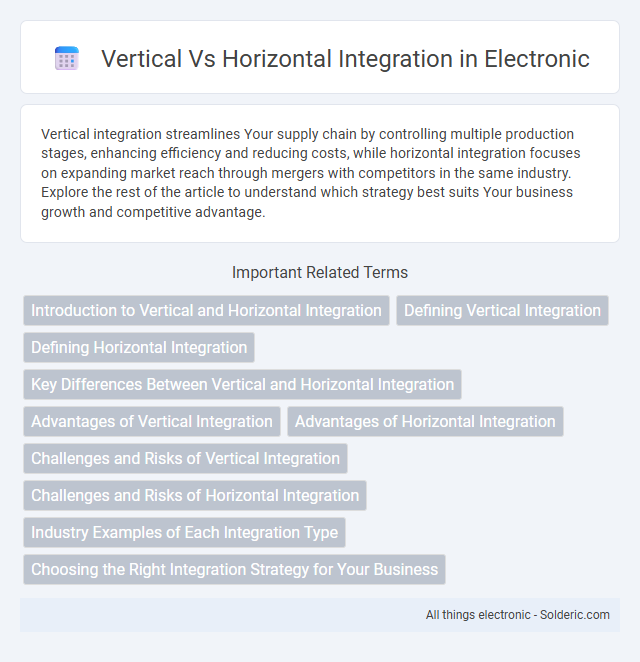Vertical integration streamlines Your supply chain by controlling multiple production stages, enhancing efficiency and reducing costs, while horizontal integration focuses on expanding market reach through mergers with competitors in the same industry. Explore the rest of the article to understand which strategy best suits Your business growth and competitive advantage.
Comparison Table
| Aspect | Vertical Integration | Horizontal Integration |
|---|---|---|
| Definition | Acquisition or control over different stages of production within the same industry supply chain. | Expansion by acquiring or merging with competitors in the same industry level. |
| Purpose | Increase control over supply chain, reduce costs, improve efficiency. | Expand market share, reduce competition, achieve economies of scale. |
| Example | A car manufacturer owning parts suppliers and dealerships. | A car manufacturer merging with another car manufacturer. |
| Benefits | Cost control, quality assurance, supply security. | Market dominance, increased customer base, cost reduction. |
| Risks | High capital investment, reduced flexibility, regulatory challenges. | Antitrust issues, cultural clashes, overextension. |
| Industries | Manufacturing, retail, energy sectors. | Telecommunications, media, consumer goods. |
Introduction to Vertical and Horizontal Integration
Vertical integration involves a company expanding its operations into different stages of production within the same industry, such as a manufacturer acquiring suppliers or distributors. Horizontal integration occurs when a business acquires or merges with competitors operating at the same level in the supply chain to increase market share and reduce competition. Your strategic choice between vertical and horizontal integration depends on whether you aim to control more of the supply process or dominate your industry by consolidating competitors.
Defining Vertical Integration
Vertical integration refers to a business strategy where a company controls multiple stages of its supply chain, from raw materials to production to distribution. This approach streamlines operations, reduces costs, and increases control over the quality and timing of products reaching the market. Your company can improve efficiency and gain competitive advantages by adopting vertical integration, aligning resources and processes closely within the industry value chain.
Defining Horizontal Integration
Horizontal integration involves a company expanding its operations by acquiring or merging with competitors operating at the same stage of the supply chain. This strategy helps businesses increase market share, reduce competition, and achieve economies of scale. Your company can gain greater control over the industry and improve competitive positioning through horizontal integration.
Key Differences Between Vertical and Horizontal Integration
Vertical integration involves a company expanding its operations into different stages of production or distribution within its supply chain, enhancing control over the entire process. Horizontal integration occurs when a business acquires or merges with competitors at the same production level to increase market share and reduce competition. The key differences lie in vertical integration controlling supply chains for efficiency and cost reduction, while horizontal integration emphasizes market consolidation and expansion.
Advantages of Vertical Integration
Vertical integration enhances supply chain control, reducing costs and improving efficiency by consolidating production stages under one company. It boosts quality management and allows faster decision-making by minimizing reliance on external suppliers or distributors. Vertical integration also strengthens competitive advantage through better market control and increased barriers for new entrants.
Advantages of Horizontal Integration
Horizontal integration allows companies to increase market share by acquiring or merging with competitors, leading to greater economies of scale and reduced operational costs. It enhances market power and bargaining strength with suppliers and customers, fostering competitive advantage and higher profit margins. This strategy facilitates diversification of products and services within the same industry, reducing risks associated with market fluctuations.
Challenges and Risks of Vertical Integration
Vertical integration poses significant challenges such as increased operational complexity and higher capital investment requirements, which can strain financial and managerial resources. Firms face risks including reduced flexibility in responding to market changes and potential conflicts of interest between different stages of production. Additionally, vertical integration may lead to regulatory scrutiny and increased exposure to supply chain disruptions.
Challenges and Risks of Horizontal Integration
Horizontal integration poses significant challenges, including regulatory scrutiny due to antitrust concerns and the complexity of merging distinct corporate cultures. The risk of overextension can lead to operational inefficiencies and dilution of core competencies, impacting Your company's competitive advantage. Market saturation and heightened competition also threaten profitability and long-term growth potential in horizontally integrated firms.
Industry Examples of Each Integration Type
Vertical integration is exemplified by companies like Apple, which controls its supply chain from manufacturing components to retail distribution, ensuring product quality and reducing costs. Horizontal integration is seen in the telecommunications industry, where firms such as Verizon acquire competitors to increase market share and expand customer base. In the automotive sector, Toyota exhibits vertical integration by managing everything from parts production to sales, while horizontal integration is illustrated by mergers like the Fiat-Chrysler alliance to enhance competitive positioning.
Choosing the Right Integration Strategy for Your Business
Selecting the right integration strategy depends on your business goals, industry dynamics, and resource capabilities. Vertical integration enhances control over the supply chain, reduces costs, and improves quality, ideal for companies seeking to streamline operations and gain competitive advantage. Horizontal integration focuses on market expansion and diversification by acquiring or merging with competitors, suitable for businesses aiming to increase market share and achieve economies of scale.
Vertical vs Horizontal Integration Infographic

 solderic.com
solderic.com